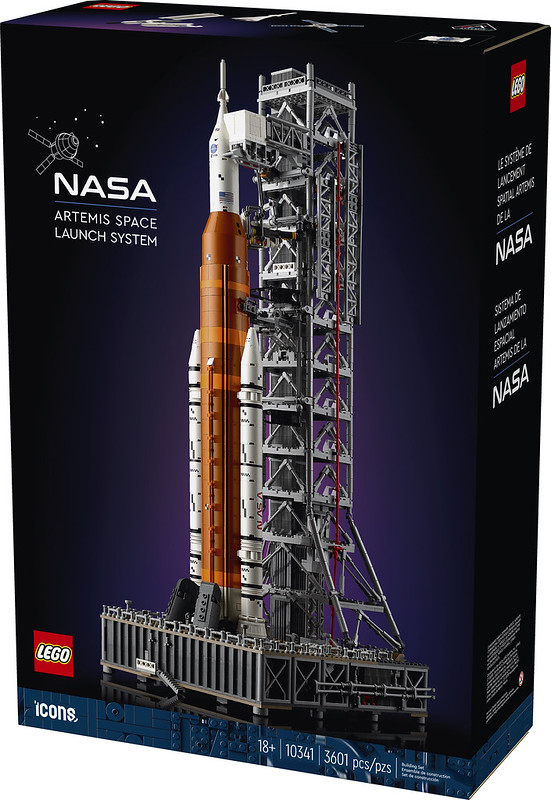The LEGO Group have always had a fondness for space. By space, I’m not talking about the colourful beloved Classic Space theme but LEGO® builds grounded in reality. Back when LEGO sets began introducing themed sets, mankind’s journey to the Moon made space all the rage but it’s an interest which has remained. This year alone, space has been a running theme across several themes and the latest comes from LEGO Icons. Although exploration of our galaxy has been limited in recent years, NASA is planning to re-establish a human presence on the Moon and beyond with the Artemis program. This new set is inspired by the new rocket and launch system which was used to launch the uncrewed Artemis rocket in 2022 and will also be used for future missions. But how does the LEGO version fare? Here’s a closer look at the Artemis Space Launch System set.
Product Details
Set Name: NASA Artemis Space Launch System | Set Number: 10341 | Pieces: 3601 | Theme: Icons
Number of Bags: Bags x 23 + Loose Elements | Instructions: Paper booklet + Builder App | Stickers: N/A | Insiders QR: Yes
RRP: £219.99/$259.99/259.99€/449.99AUD/339.99CAD
Availability: LEGO Stores & LEGO Online from May 15th (Insiders) May 18th (General)
Real-life space missions and vehicles have inspired several previous LEGO sets. Many of them have resulted in some interesting LEGO builds such as the Apollo Saturn V, Apollo Launcher Lander and the Space Shuttle Discovery. As impressive as those sets are, the latest to join them is something else entirely. The Artemis Space Launch System doesn’t just focus on the rocket but the entire mass of equipment needed to launch it into orbit. It’s been described as a microscale set and the build begins with the launchpad.
The launch pad has a footprint around the same size as a 32 x 32 stud baseplate, but various smaller plates create it. The base section of the launch pad is surprisingly detailed. Even some of the detail you can’t easily see has been included such as the various stairwells nestled behind the outer walls of the pad. One thing the base of the launch does have is a lot of repetition. The railings bordering the base’s edge are created with numerous ‘spray nozzles’. But the real repetition comes with the launch tower.
The looming tower which rises from the base is used to fuel, add payloads and eventually crew to the rocket, obviously meaning it needs to be rather tall. In LEGO form, it’s also a fairly imposing structure and one which is built in almost identical sections. This is another area of repetition. Despite this, it’s a surprisingly sturdy build. A core of bricks is clad with a scaffolding-like shell and there are a few variations it gets higher. But in essence, the tower is very much a stack of similarly built sections. Admittedly, once complete it looks impressive and offers a detailed backdrop for the rocket. But before you construct that, the tower has a few little flourishes which gives it even more detail. These include snaking runs of piping and a slightly awkward payload delivery system which is largely made up of Technic elements and is connected loosely to the tower.
It’s easy to compare the Artemis rocket to the LEGO Ideas Saturn VI, and yes there are similar traits in terms of how it’s built and some of the elements used to craft it. However, they are completely different in terms of scale. The Saturn VI remains an imposing model thanks to how tall it is. For this set, that scale is much shorter but still fairly tall. Unlike the Saturn VI, the Artemis rocket features two large orange fuel tanks, which can be detached as they would on the real rocket. You can also find a satellite in the nose of the rocket. This nearly slots inside the rockets but can be removed and mounted on a small display stand next to a small information panel. This offers an interesting
The Artemis missions may not have the visual familiarity of the past NASA missions but they will form the basis of future missions and will become visually indicative of space exploration for future generations. In terms of it being a LEGO set, yes some sections are repetitive, especially the tower. But this does result in a detailed finish which looks impressive once complete. The launch pad is certainly the main focus of the set, of course, it also needs the rocket, but the majority of the build is focused around the launchpad. There are a few sections of the build which felt a little ‘unnatural’ for a LEGO set, such as angling rails in odd ways and the seemingly ‘wonky’ base of the tower. But when comparing the set to the real-life launch system, it’s a pretty impressive recreation. Apologies for the iffy photos, it’s far too tall to fit in my usual lightbox.
Coming Soon: UKIrelandUSCanadaMexicoGermanyFranceDenmarkAustraliaNew Zealand
These were provided to BricksFanz by the LEGO Group for purposes of review. The thoughts within this review are those of BricksFanz and do not reflect those of the LEGO Group. Providing a set for free does not guarantee a favourable opinion of the set.

































Trackbacks/Pingbacks